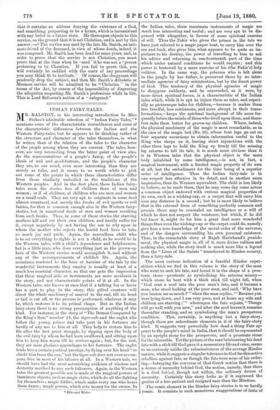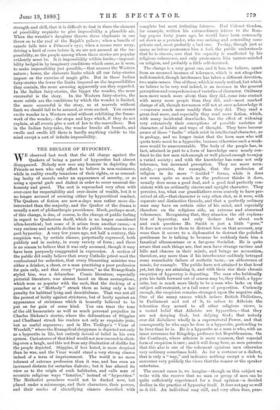INDIAN FAIRY-TALES.
MR. RALSTON, in his interesting introduction to Miss Stokes's admirable selection of "Indian Fairy Tales,"* mentions some of the characteristic resemblances and some of the characteristic differences between the Indian and the Western Fairy-tales, but he appears to be thinking rather of the structure and character of the tales themselves, in what he writes, than of the relation of the tales to the character of the people among whom they are current. The tales, how- ever, are very interesting from the latter point of view also. As the representations of a people's fancy, of the people's ideals of evil and good-fortune, and the people's character they are, to our mind, even more interesting than they are merely as tales, and it seems to us worth while to pick out some of the points in which these characteristics differ from those similarly embodied in the traditions of the Western peoples. And in the first place, these Indian fairy- tales seem the stories less of children than of men and women; or if of children, of children who are men and women on a small scale. They are very apt to originate in some deed almost unnatural, not merely the freaks of evil spirits or evil fairies, for that is common enough also in the Western fairy- stories, but in unnatural deeds of men and women resulting from such freaks. Thus, in some of these stories the starving mothers kill and eat their own children, and hardly suffer for it, except negatively by not having the son to rely upon in whom the mother who rejects the horrid food lives to take so much joy and pride. Again, the marvellous child who is to set everything to rights is not a child, as he would be in the Western tales, with a child's dependence and helplessness, but is a little man, who does everything just as the grown-up hero of the Western stories would accomplish it, and without any of the accompaniments of childish life. Again, the assistance rendered to the hero or heroine of the tale by the wonderful instruments they employ is usually at least of a much less essential character, so that one gets the impression that these magical aids or instruments are mere accidents in the story, and not characteristic points of it at all. In the Western tales, one knows at once that if a talking fox or horse has a part to play in the story, this gifted. creature will direct the whole machinery of marvel to the end, till its head or tail is cut off; or the process is performed, whatever it may be, which restores it to its primal shape. But in the Indian fairy-story there is no strong presumption of anything of the kind. For instance, in the story of "The Demon Conquered by the King's Son," number 24, the tiger-cub and the eaglet who follow the young prince and take part in his fortunes are hardly of any use to him at all. They help to restore him to life aft'er the last great struggle, by ripping open the body of the evil fairy by whom he had been swallowed, and sitting upon him to keep him warm till he revives again; but, for the rest, they are mere glorious appendages to his fortunes. The eaglet lends him a certain poetical prestige, by flying over his head "to shield him from the sun," but the tiger-cub does not even accom- pany him in most of his labours at all. In a Western tale, we should have had the most astonishing evidence of wisdom and dexterity ascribed to any, such followers. Again, in the Western tales the greatest possible use is made of the magical powers of inanimate objects, such as magic clubs, which do all the fighting for themselves ; magic fiddles, which make every one who hears them dance; magic purses, which coin money for the owner. In
• Ellis and White.
the Indian tales, these inanimate instruments of magic are much less interesting and useful ; and are very apt to be dis- pensed with altogether, in favour of some spiritual exercise of will. Thus the Fakir who gives the prince in the tale we have just referred to a magic paper boat, to carry him over the sea and back, also gives him, what appears to be quite as im- portant to his destiny, the power of travelling to him to ask his advice and returning in one-fourteenth part of the time which under natural conditions he would require ; and this power is bestowed by a mere exercise of his (the Fakir's) holy volition. In the same way, the princess who is left alone in the jungle by her father, is preserved there by no inter- mediate agencies of fairy ministration, but by the direct power of God. This tendency of the physical agencies of magic to disappear suddenly, and be superseded, as it were, by more direct spiritual forces, is a characteristic of the Indian tales which, while it is apt to injure them as tales, and especi- ally as picturesque tales for children,—because it makes them less fanciful, less continuous, and more abrupt in their trans- formations,—keeps the spiritual background of life more fre- quently before the minds of those who dwell upon them, and there- fore snits them better for grown-up children. Where, indeed, the physical machinery of the magic is most remarkable, as in the case of the magic bed (No. 26), whose four legs go out on four separate excursions to obtain information useful to the King who sleeps on it, leaving strict injunctions with the other three legs to hold the King up firmly till the missing leg returns to tell its tale, it is much more obvious than it is in Western tales that the physical object is the mere body inhabited by some intelligence,—is not, in fact, a magical instrument, with a limited magic property of its own at all, but the embodiment for the time being of a superior order of intelligence. Thus the Indian fairy-tale is in one respect less effective in its detail, and in another more impressive, than its Western equivalent. 'The child is less likely to believe, as he reads them, that he may some day come across a common object endowed with curious magical properties of its own, such as a wishing-cap, or a carpet that will carry him over any distance in a second ; but he is more likely to believe that in the external form of something perfectly common and prosaic there may be concealed an intelligence or a will of which he does not suspect the existence, but which, if he did but know it, might do for him a great deal more wonderful things than even the wishing-cap or the carpet could do, namely, give him a true knowledge of the moral order of the universe, and of the dangers surrounding his own personal existence. Thus, in the remarkable story of Rajah Harichand's punish- ment, the physical magic is, all of it, mere divine volition and nothing else, while the story itself is much more like a legend from the "Lives of the Saints" transferred to Hindoo scenery, than a fairy-tale.
The most curious indication of a fanciful Hindoo super- stition which we find in this volume is the story of the man who went to seek his fate, and found it in the shape of a pros- trate stone—prostrate as symbolising his extreme misery— which stone he beat with a thick stick till night fell, when "God sent a soul into the poor man's fate, and it became a man, who stood looking at the poor man, and said, 'Why have you beaten me so much ?' when the man replies, " Because you were lying down, and I am very poor, and at home my wife and children are starving ;' " whereupon the fate rejoins, "Things will go well with you now," and after the soul leaves it remains thereafter standing, and so symbolising the man's prosperous condition. This, certainly, is anything but a fairy-story, though there are subordinate elements in it of the fairy-story kind. It suggests very powerfully how dead a thing Fate ap- pears to the people's mind in India, that it should be represented by an upright stone for the prosperous, and a prostrate stone for the miserable. Yetthe picture of the man belabouring his dead fate with a stick till God gave it a momentary life andvoice, seems to us curiously unlike the submissiveness of the average Hindoo nature; while it suggests a singular tolerance in God for this active rebellion against fate, as though the fate were none of his order- ing,—betraying the converse of that Greek notion that there is a decree of necessity behind God, the notion, namely, that there is a God behind, though not within, the ordinary decree of necessity. Certainly this story looks as if it expressed the genius of a less patient and resigned race than the Hmdoos.
The comic element in the Hindoo fairy-stories is to us hardly comic. It consists in such monstrous exaggerations of feats of strength and skill, that it is difficult to find in them the element of possibility requisite to give impossibility a plausible air. When the wrestler's daughter throws three elephants in one throw on to the roof of the Rajah's palace ; when a bundle of camels falls into a Princess's eye ; when a mouse runs away, driving a herd of cows before it, we are not amused at the im- possibility, as the people among whom these stories are popular evidently must be. It is impossibility within limits,—impossi- bility hedged in by imaginary conditions which seem, as it were, to make impossibility just possible,—that amuses the Western nature ; hence, the elaborate limits which all our fairy-stories impose on the exercise of magic gifts. But in these Indian fairy-stories the fewer the limits imposed on the impossibilities they contain, the more amusing apparently are they regarded. In the Indian fairy-stories, the bigger the wonder, the more successful is the story. In the Western fairy-stories, the more subtle are the conditions by which the wonder is limited, the more successful is the story, as at marvels without limit we should fail to be amused, or even excited. You cannot excite wonder in a Western mind without exhibiting the frame- work of the wonder,—the stops and keys which, if they do not explain, at all events give a sort of law to the marvellous. But in the Indian fairy-tales, the wonder breaks all bounds, and swells and swells till there is hardly anything visible to the mind except a sort of infinite impossibility.



































 Previous page
Previous page